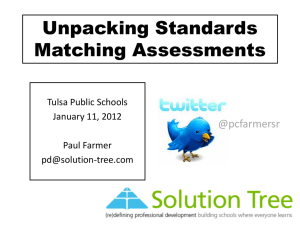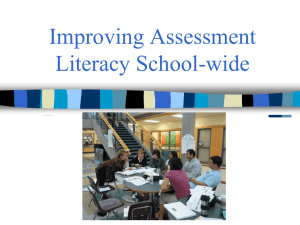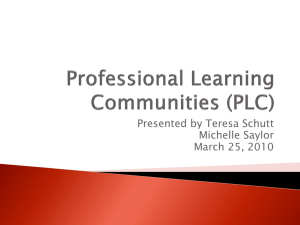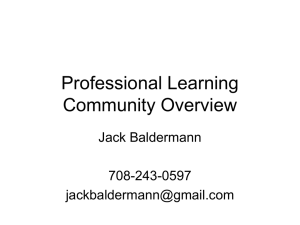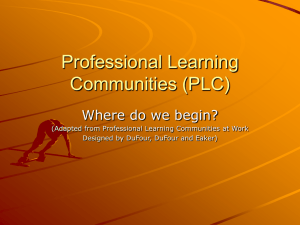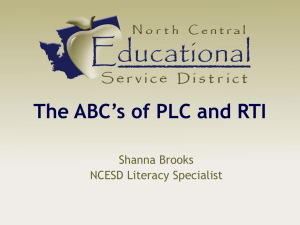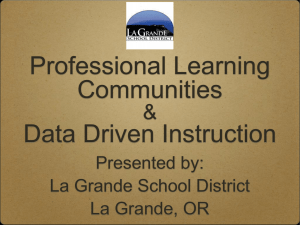Finding Common Ground in Educational Reform
advertisement
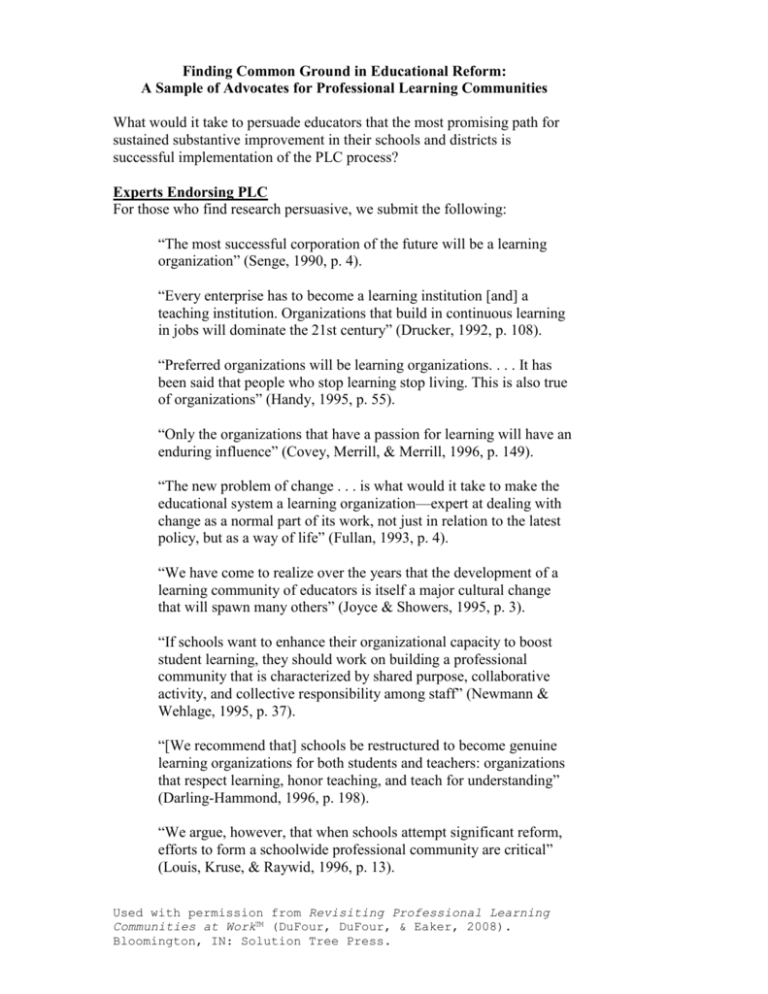
Finding Common Ground in Educational Reform: A Sample of Advocates for Professional Learning Communities What would it take to persuade educators that the most promising path for sustained substantive improvement in their schools and districts is successful implementation of the PLC process? Experts Endorsing PLC For those who find research persuasive, we submit the following: “The most successful corporation of the future will be a learning organization” (Senge, 1990, p. 4). “Every enterprise has to become a learning institution [and] a teaching institution. Organizations that build in continuous learning in jobs will dominate the 21st century” (Drucker, 1992, p. 108). “Preferred organizations will be learning organizations. . . . It has been said that people who stop learning stop living. This is also true of organizations” (Handy, 1995, p. 55). “Only the organizations that have a passion for learning will have an enduring influence” (Covey, Merrill, & Merrill, 1996, p. 149). “The new problem of change . . . is what would it take to make the educational system a learning organization—expert at dealing with change as a normal part of its work, not just in relation to the latest policy, but as a way of life” (Fullan, 1993, p. 4). “We have come to realize over the years that the development of a learning community of educators is itself a major cultural change that will spawn many others” (Joyce & Showers, 1995, p. 3). “If schools want to enhance their organizational capacity to boost student learning, they should work on building a professional community that is characterized by shared purpose, collaborative activity, and collective responsibility among staff” (Newmann & Wehlage, 1995, p. 37). “[We recommend that] schools be restructured to become genuine learning organizations for both students and teachers: organizations that respect learning, honor teaching, and teach for understanding” (Darling-Hammond, 1996, p. 198). “We argue, however, that when schools attempt significant reform, efforts to form a schoolwide professional community are critical” (Louis, Kruse, & Raywid, 1996, p. 13). Used with permission from Revisiting Professional Learning Communities at Work™ (DuFour, DuFour, & Eaker, 2008). Bloomington, IN: Solution Tree Press. “When a school is organized into a professional community: 1. Teachers set higher expectations for student achievement, 2. Students can count on the help of their teachers and peers in achieving ambitious learning goals, 3. The quality of classroom pedagogy is considerably higher, and 4. Achievement levels are significantly higher” (Louis & Marks, 1998). “Professional learning communities offer an infrastructure to create the supportive cultures and conditions necessary for achieving significant gains in teaching and learning. Professional learning communities provide opportunities for professional staff to look deeply into the teaching and learning process and to learn how to become more effective in their work with students” (Morrissey, 2000). “The framework of a professional learning community is inextricably linked to the effective integration of standards, assessment, and accountability . . . the leaders of professional learning communities balance the desire for professional autonomy with the fundamental principles and values that drive collaboration and mutual accountability” (Reeves, 2005, pp. 47–48). “The use of professional learning communities is the best, least expensive, most professionally rewarding way to improve schools. . . . Such communities hold out immense, unprecedented hope for schools and the improvement of teaching” (Schmoker, 2005, pp. 137–138). “Well-implemented professional learning communities are a powerful means of seamlessly blending teaching and professional learning in ways that produce complex, intelligent behavior in all teachers” (Sparks, 2005, p. 156). “Strong professional learning communities produce schools that are engines of hope and achievement for students. . . . There is nothing more important for education in the decades ahead than educating and supporting leaders in the commitments, understandings, and skills necessary to grow such schools where a focus on effort-based ability is the norm” (Saphier, 2005, p. 111). “Participation in learning communities impacts teaching practice as teachers become more student centered. In addition, teaching culture is improved because the learning communities increase collaboration, a focus on student learning, teacher authority or empowerment, and continuous learning. When teachers participate in a learning community, students benefit as well, as indicated by improved achievement scores over time. The collective results of Used with permission from Revisiting Professional Learning Communities at Work™ (DuFour, DuFour, & Eaker, 2008). Bloomington, IN: Solution Tree Press. these studies offer an unequivocal answer to the question about whether the literature supports the assumption that student learning increases when teachers participate in professional learning communities. The answer is a resounding and encouraging yes” (Vescio, Ross, & Adams, 2006, pp. 15–16). “Research has steadily converged on the importance of strong teacher learning communities for teacher growth and commitment, suggesting as well their potential contribution to favorable student outcomes. . . . Effective professional development might thus be judged by its capacity for building (and building on) the structures and values, as well as the intellectual and leadership resources of professional community” (Little, 2006, p. 2). “The notion of professional learning communities (PLCs) has really taken off around the world. Researchers have focused attention on the topic for some time, especially in North America, but there’s a growing realization that professional learning communities hold considerable promise for supporting implementation of improvement initiatives and the progress of educational reform more generally. An effective professional learning community has the capacity to promote and sustain the learning of all professionals in the school community with the collective purpose of enhancing pupil learning” (Stoll, Bolam, McMahon, Thomas, Wallace, Greenwood, & Hawkey, 2006, pp. 3–4). “We studied student achievement in fourth-grade math and reading and found fourth-grade students have higher achievement in both when they attend schools characterized by higher levels of teacher collaboration for school improvement. Teacher collaboration was found to have a significant effect. Schools with a one standard deviation increase in teacher collaboration showed a .07–.08 standard deviation increase in fourth-grade test scores. This holds true even when student characteristics such as race, gender, or socioeconomic status are taken into account” (Goddard, Goddard, & Tschannen-Moran, 2007, p. 880). “Findings from many studies suggest that participation in a professional community with one’s colleagues is an integral part of professional learning that impacts positively on students” (Timperley, 2008, p. 19). “Successful systems are creating more opportunities and spaces for teachers to work together in sharing practices and research, developing lesson plans, and building consensus on what constitutes good teaching practice. . . . The expansion of professional learning communities (PLCs) is indicative of the increased emphasis on teacher collaboration as the means of powerful professional Used with permission from Revisiting Professional Learning Communities at Work™ (DuFour, DuFour, & Eaker, 2008). Bloomington, IN: Solution Tree Press. development. Through effective PLCs, teachers work together to research, try, and share best practices; analyze and constantly aim for high, internationally benchmarked standards; analyze student data and plan instruction; map and articulate curriculum; and observe and coach each other. PLCs are an indication of a broader trend toward professional development that is increasingly collaborative, datadriven, and peer facilitated, all with a focus on classroom practice” (Barber & Mourshed, 2009, p. 30). “In general, a school-based professional community entails new work arrangements for faculty that (1) make teachers’ classroom work public for examination by colleagues and external consultants; (2) institute processes of critical dialogue about classroom practices (for example, what is and is not happening in our classrooms? How do we know that something is actually working? Where is the evidence of student learning? Are there other practices that might work better, and how might we figure this out?); and (3) sustain collaboration among teachers that focuses on strengthening the school’s instructional guidance system. Strong instructional leaders promote the growth of a professional community around a shared system of teaching and learning and also stay the course, guided by a coherent, strategic plan that aims to advance the entire enterprise over time” (Bryk, Allensworth, Sebring, Luppescu, & Easton, 2010, p. 56). “It is no accident that the standards for professional learning begin with the standard on learning communities. While many forms of professional learning may lead to improved knowledge and skills for adults, only the learning community offers a structure, process, and product that lead to systematic continuous improvement for both educators and students” (Hirsh, 2012, p. 64). Organizations Endorsing PLC For educators who are not persuaded by research, perhaps the endorsement of professional organizations would make them more amenable to the potential of PLCs. For example, some organizations have been created to make teaching more rewarding and satisfying. The following are some of the recommendations of those organizations: The fundamental premise of the National Commission on Teaching and America’s Future is that school reform cannot succeed without creating conditions in which teachers teach well. The commission has identified the creation of “strong learning communities” as one of its three core strategies for improving both teaching and schools: “Quality teaching requires strong, professional learning communities. Collegial interchange, not isolation, must become the norm for teachers. Communities of learning can no longer be Used with permission from Revisiting Professional Learning Communities at Work™ (DuFour, DuFour, & Eaker, 2008). Bloomington, IN: Solution Tree Press. considered utopian; they must become the building blocks that establish a new foundation for America’s schools” (National Commission on Teaching and America’s Future, 2003, p. 17). The National Board of Professional Teaching Standards was formed to advance the quality of teaching and learning by developing professional standards for accomplished teaching. Its position statement includes: “Proposition Five: Teachers are members of learning communities. National Board Certified Teachers collaborate with others to improve student learning. They work with other professionals on instructional policy, curriculum development, and staff development” (National Board of Professional Teaching Standards, 2007). The Interstate New Teacher Assessment and Support Consortium (INTASC) was created by the Council of Chief State School Officers to develop a common core of teaching knowledge which would clarify the knowledge, skills, and dispositions all teachers should demonstrate to be considered “professional.” The standards include: “Professional teachers assume roles that extend beyond the classroom and include responsibilities for developing the school as a learning organization. . . . Professional teachers are responsible for planning and pursuing their ongoing learning, for reflecting with colleagues on their practice, and for contributing to the profession’s knowledge base” (INTASC, 1992, p. 13). The National Supervisors of Teachers of Mathematics (NCTM) called upon math leaders to: “(1) Ensure teachers work interdependently as a professional learning community to guarantee continuous improvement and gains in student achievement. (2) Create the support and structures necessary to implement a professional learning community. (3) Ensure a systemic implementation of a professional learning community throughout all aspects of the mathematics curriculum, instruction, and assessment at the school, district, or regional level” (NCTM, 2008). In 2012 and 2013, the NCTM copublished a series of books on using the PLC at Work™ process for implementing the Common Core State Standards in mathematics. The National Council of Teachers of English (NCTE) passed a resolution supporting PLCs and has created the Professional Learning Communities at Work™ series—topical resource kits to help teachers work as PLCs. An Used with permission from Revisiting Professional Learning Communities at Work™ (DuFour, DuFour, & Eaker, 2008). Bloomington, IN: Solution Tree Press. NCTE position paper argued that PLCs make teaching more rewarding and combats the problem of educators leaving the profession: “Effective professional development fosters collegial relationships, creating professional communities where teachers share knowledge and treat each other with respect. Within such communities, teacher inquiry and reflection can flourish, and research shows that teachers who engage in collaborative professional development feel confident and well prepared to meet the demands of teaching” (NCTE, 2006). The National Science Teachers Association issued a position paper in 2006, asserting that a key component of high-quality staff development would “facilitate the development of professional learning communities” (National Science Teachers Association, 2006). The National Education Association (NEA), America’s largest teaching organization with over 2.7 million members, certainly is committed to making teaching more rewarding and satisfying. In pursuit of its long-term vision of “a great public school for every student,” the NEA has created its own recommended school improvement model, The Keys to Excellence. The model is intended to help educators “with school improvement plans and meeting the challenges of the No Child Left Behind Act” (NEA, 2003). Although the model never uses the term “professional learning community,” its six keys to a quality school are consistent with PLC principles. The NEA keys and examples of some of the specific indicators the organization has identified for each include: 1. Shared understanding and commitment to high goals “The staff has a collective commitment to and takes responsibility for implementing high standards for all students.” “The school operates under the assumption that all students can learn.” 2. Open communication and collaborative problem solving “Teachers and staff collaborate to remove barriers to student learning.” “Teachers communicate regularly with each other about effective teaching and learning strategies.” 3. Continuous assessment for teaching and learning “Student assessment is used for decision making to improve learning.” “A variety of assessment techniques are used.” 4. Personal and professional learning “Teachers have regularly scheduled time to learn from one another.” Used with permission from Revisiting Professional Learning Communities at Work™ (DuFour, DuFour, & Eaker, 2008). Bloomington, IN: Solution Tree Press. “Professional development has a direct, positive effect on teaching.” 5. Resources to support teaching and learning “Computer hardware and software supplies are adequate for students and teachers.” “Support services are adequate.” 6. Curriculum and instruction “Instruction includes interventions for students who are not succeeding.” “Teachers are open to new learnings and rethink their approaches to teaching and assessment practices based on teacher-directed action research and other classroom-based inquiries” (NEA, 2003). The American Federation of Teachers (AFT) passed a resolution encouraging teachers to reflect on their practice and share what they have learned with colleagues in order to “fundamentally reshape school culture, turning the school into a professional learning community, reducing isolation, and opening new leadership opportunities for teachers” (AFT, 2010). Furthermore, its Center for School Improvement Leadership Institute includes a component designed to “identify and examine attributes of effective professional development and professional learning communities” (AFT, 2013). Principal organizations have been unanimous in urging their members to organize schools into PLCs. For example: The National Association of Elementary School Principals (2001) has clarified the essential responsibilities of that position in its publication, Leading Learning Communities: Standards for What Principals Should Know and Be Able to Do. The first book in its new series, Essentials for Principals, published in 2012, was titled The School Leader’s Guide to Professional Learning Communities at Work™. The National Association of Secondary School Principals calls on high schools to engage in an improvement process that will ensure success for every high school student. In Breaking Ranks II, the National Association of Secondary School Principals (2004) urges principals to focus on the development of a “professional learning community” within each school as a primary improvement strategy. In Breaking Ranks in the Middle, the National Association of Secondary School Principals (2006) organizes 30 recommendations for improving middle schools into three general areas, the first of which calls for “Collaborative Leadership and Professional Learning Communities” (p. 23). Used with permission from Revisiting Professional Learning Communities at Work™ (DuFour, DuFour, & Eaker, 2008). Bloomington, IN: Solution Tree Press. In 2012, the Executive Board of the Association of Middle Level Educators endorsed a research report that concluded the PLC process is consistent with the middle school philosophy and urged principals to develop the capacity of staff to function as PLCs. This review of the research stated: “The PLC focus on responsive networks of school individuals, continuous reflection directed at student learning, and ongoing focus on teacher development to meet school and student needs corresponds well with the middle level concept articulated in This We Believe: Keys to Educating Young Adolescents (National Middle School Association, 2010). . . . PLCs have a consistently positive impact on student achievement results. Educators can and should take comprehensive knowledge and experience related to developmentally responsive middle level schools and teachers on the journey toward the professional learning community” (Ruebel, 2011). Organizations created to support school reform endorse the PLC process. For example: “We support and encourage the use of professional learning communities (PLCs) as a central element for effective professional development and a comprehensive reform initiative. In our experience, PLCs have the potential to enhance the professional culture within a school district” (Annenberg Institute for School Reform, 2004). The North Central Association (NCA) called for member schools to operate as PLCs. It wrote, “Working at complementary levels—the school and classroom—the NCA school improvement and PLC processes reinforce and strengthen one another. They are not mutually exclusive, but rather mutually supportive. If we want to ensure that no child is left behind, we must understand the important relationship between the NCA school improvement process and PLC. The use of PLC at the classroom level has dramatically increased teachers’ ability to implement a guaranteed and viable curriculum, monitor student progress with colleagues on school improvement goals and curriculum objectives, and improve the teaching and learning process. The strong link between school improvement goals and PLC at the classroom level allows all children to be successful” (Colliton, 2005). In Empowering Learners: Guidelines for School Librarians, the American Association of School Librarians (2009) has called on its members to “collaborate with members of professional learning communities as both learners and teachers.” The American Educational Research Association (2005) has concluded that “the more time teachers spend on professional development, the more significantly they change their practice, and participating in professional learning communities optimizes the time spent on professional development” (pp. 3–4). Used with permission from Revisiting Professional Learning Communities at Work™ (DuFour, DuFour, & Eaker, 2008). Bloomington, IN: Solution Tree Press. The National Center for Educational Achievement found that teachers and administrators in high-performing, low-SES schools continually used student data to evaluate, adjust, and align instruction. Teachers report that student data from formative assessments and state tests help them identify gaps in instruction or ways that instruction needs to be changed or tailored to individual student needs. Assessment results are also used to adjust instruction in response to the strengths and weaknesses of entire groups of students (National Center for Educational Achievement, 2009). Learning Forward (formerly the National Staff Development Council) has established standards for effective professional development. The first standard calls for schools to be organized as PLCs. “Professional learning that increases educator effectiveness and results for all students occurs within learning communities committed to continuous improvement, collective responsibility, and goal alignment” (Learning Forward, 2011). Studies Supporting PLC The following are some specific studies on PLC and school improvement that you can reference: The Center on Organization and Restructuring of Schools conducted a fiveyear study in the early 1990s that included analysis of data from over 1,500 elementary, middle, and high schools throughout the United States. The center also conducted field research in 44 schools in 16 states. Schools that were successful in linking their improvement initiatives with improved student learning were characterized by the following: 1. Focus on agreed vision of what students should learn 2. Teaching that requires students to think, to develop in-depth understanding, and to apply academic learning to important, realistic problems. 3. Schools that function as professional learning communities in which teachers: a. Are guided by a clear, commonly held, shared purpose for student learning b. Feel a sense of collective responsibility for student learning c. Collaborate with one another to promote student learning d. Enjoy increased autonomy at the school site (Newmann & Wehlage, 1995). Another analysis of the data collected by the Center on Organization and Restructuring of Schools agreed the development of professional learning communities was critical to improving schools and elaborated on the conditions that led to successful PLCs. Kruse, Seashore Louis, and Bryk (1994) argue that in a PLC, teachers are committed to: 1. Reflective dialogue based on a shared set of norms, beliefs, and values that allow them to critique their individual and collective performance Used with permission from Revisiting Professional Learning Communities at Work™ (DuFour, DuFour, & Eaker, 2008). Bloomington, IN: Solution Tree Press. 2. De-privatization of practice that requires teachers to share, observe, and discuss each other’s methods and philosophies 3. Collective focus on student learning fueled by the belief that all students can learn and that staff members have a mutual obligation to see to it students learn 4. Collaboration that moves beyond dialogue about students to producing materials that improve instruction, curriculum, and assessment for students 5. Shared norms and values that affirm common ground on critical educational issues and a collective focus on student learning The study also reported these five factors are supported by structural conditions such as time to meet during the school day, teachers organized into collaborative teams that work together interdependently to achieve common goals, open communication within and across teams, and teacher autonomy guided by a shared sense of purpose, priorities, and norms. Social resources that support professional learning communities include commitment to continuous improvement, high levels of trust and respect, sharing of effective teaching practices, supportive leadership, and focused orientation for those new to the school. The Partnership for 21st Century Skills (2013) has called for schools to be organized into professional learning communities in order to model and teach the skills students will need. The organization argues that the best environment for teaching 21st century skills is a professional learning community that enable educators to collaborate, share best practices, and integrate 21st century skills into classroom practice (Partnership for 21st Century Skills, 2009). After studying the impact of interim assessments in targeted Philadelphia schools, Research for Action concluded, “Translating student data into student achievement requires a strong learning community at the school. The instructional leadership and collective responsibility measures imply that school leaders and faculty feel accountable to one another, that they are diligent in monitoring student progress, and that they are willing to use data as a starting point for inquiry” (Christman, Neild, Bulkley, Blanc, Liu, Mitchell, & Travers, 2009). “Our key finding—the central importance of a professional community to adult and student learning—will be no surprise to those familiar with other educational research” (WestEd, 2000, p. 11). Studies from the University of Chicago Center on School Reform, the National Center for Educational Attainment of schools in five states, and the Century Foundation affirm that a collaborative organizational culture focused on improving student learning; the use of frequent assessments as diagnostic tools to detect and respond to difficulties that teachers are encountering, as well as students; and explicit commitments of significant Used with permission from Revisiting Professional Learning Communities at Work™ (DuFour, DuFour, & Eaker, 2008). Bloomington, IN: Solution Tree Press. time dedicated to enabling robust internal communication and extra assistance to those who are struggling are keys to successful low-income schools and districts. In contrast to the traditional institutional design of schools dating back to the 19th century—in which each teacher has enormous autonomy, isolated in a classroom and working under a rigid administrative hierarchy—many of the successful public schools share the traits of modern high-performance workplaces, fostering cultures built on teamwork and shared sense of mission (Anrig, 2013). The National Commission on Teaching and America’s Future and WestEd partnered in a two-year project to analyze nearly 200 research articles and reports on the impact of professional learning communities on STEM teaching. This report compiles compelling evidence that when teachers team up with their colleagues, they are able to create a culture of success in schools that results in teaching improvements and student learning gains. The report advised policy makers and educators to redesign our education system to support great team teaching, not the heroic efforts of isolated individuals in self-contained classrooms. As it concluded, “Collaboration is the key to a rewarding career that will attract and retain highly skilled professionals, resulting in higher-impact teaching and deeper student learning. It’s time for educators to harness the power of teamwork found in all other successful 21st century professions” (National Commission on Teaching and America’s Future, 2012). Research Supporting the Three Big Ideas Another approach is to break the PLC concept into the three big ideas we talk about in Learning by Doing (2010)—a focus on learning, a culture of collaboration, and a focus on results—and show the research behind each. For example, the following is some research on the importance of a collaborative culture: “The single most important factor for successful school restructuring and the first order of business for those interested in increasing the capacity of their schools is building a collaborative internal environment that fosters cooperative problem solving and conflict resolution” (Eastwood & Seashore Louis, 1992, p. 215). “The ability to collaborate—on both a small and large scale—is becoming one of the core requisites of postmodern society. . . . In short, without collaborative skills and relationships, it is not possible to learn and to continue to learn as much as you need in order to be an agent for social improvement” (Fullan, 1993, pp. 17–18). Used with permission from Revisiting Professional Learning Communities at Work™ (DuFour, DuFour, & Eaker, 2008). Bloomington, IN: Solution Tree Press. “An interdependent work structure strengthens professional community. When teachers work in groups that require coordination, this, by definition, requires collaboration. When groups, rather than individuals, are seen as the main units for implementing curriculum, instruction, and assessment, they facilitate development of shared purpose for student learning and collective responsibility to achieve it” (Newmann & Wehlage, 1995, pp. 37–38). “The key to ensuring that every child has a quality teacher is finding a way for school systems to organize the work of qualified teachers so they can collaborate with their colleagues in developing strong learning communities that will sustain them as they become more accomplished teachers” (National Commission on Teaching and America’s Future, 2003, p. 7). “Collaboration and the ability to engage in collaborative action are becoming increasingly important to the survival of the public schools. Indeed, without the ability to collaborate with others, the prospect of truly repositioning schools in the constellation of community forces is not likely” (Schlechty, 2005, p. 22). “A precondition for doing anything to strengthen our practice and improve a school is the existence of a collegial culture in which professionals talk about practice, share their craft knowledge, and observe and root for the success of one another. Without these in place, no meaningful improvement—no staff or curriculum development, no teacher leadership, no student appraisal, no team teaching, no parent involvement, and no sustained change—is possible” (Barth, 2006, p. 13). “It is time to end the practice of solo teaching in isolated classrooms. Teacher induction and professional development in 21st century schools must move beyond honing one’s craft Used with permission from Revisiting Professional Learning Communities at Work™ (DuFour, DuFour, & Eaker, 2008). Bloomington, IN: Solution Tree Press. and personal repertoire of skills. Today’s teachers must transform their personal knowledge into a collectively built, widely shared, and cohesive professional knowledge base” (Fulton, Yoon, & Lee, 2005, p. 4). “In modern organizations, people need each other; almost everyone works interdependently. Employees left entirely to their own devices, without any assistance or support from someone else, accomplish very little” (Amabile & Kramer, 2011, p. 105). “In the systems we encountered that had established strong routines of collaborative practice, system leaders bore witness to three changes that collaborative practice had brought about. First, it had moved their schools from a situation in which teachers were like private emperors to one where teaching practice is made public and the entire teaching profession shares responsibility for student learning. Second, they report a cultural shift, moving from an emphasis on what teachers teach to one on what students learn. . . . Third, they report collaborative practice develops a normative model of ‘good instruction’—the pedagogy of the user interface—and makes teachers the custodians of that model. This is the characteristic of a true profession” (Mourshed, Chijioke, & Barber, 2010, pp. 89–91). “The nation has a pressing need and an unprecedented opportunity to improve school performance by using learning teams to systematically induct new teachers into a collaborative learning culture—teams that embed continuous professional development into the day-to-day fabric of work in schools” (Carroll, 2010). “The common themes in what makes various strategies successful are . . . teachers talking with other teachers about teaching and planning, deliberate attention to learning intentions and success criteria, and a constant effort to ensure teachers are seeking feedback Used with permission from Revisiting Professional Learning Communities at Work™ (DuFour, DuFour, & Eaker, 2008). Bloomington, IN: Solution Tree Press. information as to the success of their teaching on their students” (Hattie, 2009, p. 36). “To meet the needs of today’s learners, the tradition of artisan teaching in solo‐practice classrooms will have to give way to a school culture in which teachers continuously develop their content knowledge and pedagogical skills through collaborative practice that is embedded in the daily fabric of their work. Teacher collaboration supports student learning, and the good news is that teachers who work in strong learning communities are more satisfied with their careers and are more likely to remain in teaching long enough to become accomplished educators” (Fulton & Britton, 2011). “Nowadays, professional cultures are more collaborative. . . . They are places where teachers share collective responsibility for all their students. . . . They are places where teachers constantly inquire into learning and problems together, drawing on their different experiences of particular children or strategies, and on what the evidence is telling them. . . . The days when individual teachers could do anything they liked, good or bad, right or wrong, are numbered and in many places are now gone altogether. Teaching is a profession with shared purposes, collective responsibility, and mutual learning. Teaching is no longer a job where you can hog all the children to yourself. If that’s what you still believe, then it’s time to leave for another profession, because unless you share the responsibility and emotional rewards with your colleagues, you’re no longer a professional at all” (Hargreaves & Fullan, 2012, pp. 143–44). Professional organizations for educators have endorsed the premise that educators should work together collaboratively. Consider the conclusions of the following organizations: “Some of the most important forms of professional learning and problem solving occur in group settings within schools and school districts. Organized groups provide the social interaction that often deepens learning and the interpersonal support and synergy necessary for creatively solving the complex problems of teaching and learning. And because many of the recommendations Used with permission from Revisiting Professional Learning Communities at Work™ (DuFour, DuFour, & Eaker, 2008). Bloomington, IN: Solution Tree Press. contained in these standards advocate for increased teamwork among teachers and administrators in designing lessons, critiquing student work, and analyzing various types of data, among other tasks, it is imperative that professional learning be directed at improving the quality of collaborative work” (National Staff Development Council, 2007). “High-performing schools tend to promote collaborative cultures, support professional communities and exchanges among all staff, and cultivate strong ties among the school, parents, and community. . . . Teachers and staff collaborate to remove barriers to student learning. . . . Teachers communicate regularly with each other about effective teaching and learning strategies” (National Education Association, 2005). “A school does not become a great place to learn until teachers have the leadership and support they need to create a collaborative culture. Teachers working together are more effective than even the best of them can be working alone” (National Commission on Teaching and America’s Future, 2012, p. 1). “[Accomplished teachers] collaborate with others to improve student learning. . . . They work with other professionals on instructional policy, curriculum development, and staff development” (National Board of Professional Teaching Standards, 2007). “Successful middle-level teacher preparation programs place a high premium on teaching prospective and practicing middle-level teachers about the importance of collaboration with colleagues and other stakeholders. One of the unique characteristics of middle-level schools for teachers is the heavy emphasis on collaboration. . . . Teachers are not operating in isolation. This permits insights and understandings about young adolescent students to be shared with others and therefore maximized” (National Middle School Association, 2006). Used with permission from Revisiting Professional Learning Communities at Work™ (DuFour, DuFour, & Eaker, 2008). Bloomington, IN: Solution Tree Press. “Isolation is the enemy of learning. Principals who support the learning of adults in their school organize teachers’ schedules to provide opportunities for teachers to work, plan, and think together. For instance, teams of teachers who share responsibility for the learning of all students meet regularly to plan lessons, critique student work and the assignments that led to it, and solve common instructional or classroom management problems” (National Association of Elementary School Principals, 2001, p. 45). “A high school will regard itself as a community in which members of the staff collaborate to develop and implement the school’s learning goals. Teachers will provide the leadership essential to the success of reform, collaborating with others in the educational community to redefine the role of the teacher and to identify sources of support for that redefined role” (National Association of Secondary School Principals, 2004, p. 4). The third big idea of a professional learning community—a focus on results—has been endorsed by many experts. Evidence-based decision making is key to producing a results orientation in education. Consider the following statements: “An astonishing number of educational leaders make critical decisions about curriculum, instruction, assessment, and placement on the basis of information that is inadequate, misunderstood, misrepresented, or simply absent. Even when information is abundant and clear, I have witnessed leaders who are sincere and decent people stare directly at the information available to them, and then blithely ignore it. . . . Strategic leaders are worthy of the name because of their consistent linking of evidence to decision making. They respond to challenges not by scoring rhetorical points, but by consistently elevating evidence over assertion” (Reeves, 2006, p. 95). Used with permission from Revisiting Professional Learning Communities at Work™ (DuFour, DuFour, & Eaker, 2008). Bloomington, IN: Solution Tree Press. “School systems must create a culture that places value on managing by results, rather than on managing by programs. It is essential that leaders work to establish a culture where results are carefully assessed and actions are taken based on these assessments” (Schlechty, 2005). “Concentrating on results does not negate the importance of process. On the contrary, the two are interdependent: results tell us which processes are most effective and to what extent and whether processes need reexamining and adjusting. Processes exist for results and results should inform processes” (Schmoker, 1996, p. 4). “What does it take to close the achievement gaps? Our findings suggest that it comes down to how schools use data. Teachers in gapclosing schools more frequently use data to understand the skill gaps of low-achieving students. . . . When data points to a weakness in students’ academic skills, gap-closing schools are more likely to focus in on that area, making tough choices to ensure that students are immersed in what they most need” (Symonds, 2004, p. 13). “There is no recipe, no professional development set of worksheets, no new teaching method, and no Band-Aid remedy. It is a way of thinking—‘My role, as teacher, is to evaluate the effect I have on my students.’ This requires that teachers gather defensible and dependable evidence from many sources and hold collaborative discussions with colleagues and students about this evidence, thus making the effect of their teaching visible to themselves and to others” (Hattie, 2011, p. 19). “When the school is organized to focus on a small number of shared goals, and when professional learning is targeted to those goals and is a collective enterprise, the evidence is overwhelming that they do dramatically better by way of student achievement” (Fullan, in press). Used with permission from Revisiting Professional Learning Communities at Work™ (DuFour, DuFour, & Eaker, 2008). Bloomington, IN: Solution Tree Press. In fact, evidence-based decisions are so important to establishing a results orientation in any organization that many experts outside education have advocated for using data in this manner: “The ultimate measure of a great team is results. Effective teams avoid ambiguity and interpretation when it comes to results. They decide what they want to achieve, then they clarify how they will measure their progress. They select one or two indicators they can collectively focus upon and around which they can rally. They create a scoreboard that helps keep them focused on results. These teams use the scoreboard to monitor their progress against the expected achievement” (Lencioni, 2005, p. 69). “Companies operate under the false assumption that if they carry out enough of the ‘right’ improvement activities, actual performance improvements will inevitably materialize. At the heart of this assumption, which we call ‘activity centered,’ is a fundamentally flawed logic that confuses ends with means, processes with outcomes. Payoffs from the infusion of activities will be meager at best. And there is in fact an alternative: results-driven improvement processes that focus on achieving specific, measurable operational improvements within a few months” (Schaffer & Thomson, 1998, p. 191). “Goal setting is the single most powerful motivational tool in a leader’s toolkit. Why? Because goal setting operates in ways that provide purpose, challenge, and meaning. Goals are the guideposts along the road that make a compelling vision come alive” (Blanchard, 2007, p. 150). “Unless you can subject your decision making to a ruthless and continuous JUDGMENT BY RESULTS, all your zigs and zags will only be random lunges in the dark, sooner or later bound to land you on the rocks” (Champy, 1995, p. 120). Used with permission from Revisiting Professional Learning Communities at Work™ (DuFour, DuFour, & Eaker, 2008). Bloomington, IN: Solution Tree Press. “Ducking the facts about performance for fear of being judged, criticized, humiliated, and punished characterizes losing streaks, not winning streaks. In a losing streak, facts are used for blame, not improvement; they are turned into weapons to persecute, not tools to find solutions. . . . In winning streaks, players get and use abundant feedback about their performance. Leaders can . . . ensure that measurements ultimately empower rather than punish people” (Kanter, 2004, p. 208). Leaders should “set group performance goals that require people to collaborate. . . . Having common goals allows you to motivate team as well as individual performance” (Katzenbach & Kahn, 2010, p. 117). Used with permission from Revisiting Professional Learning Communities at Work™ (DuFour, DuFour, & Eaker, 2008). Bloomington, IN: Solution Tree Press. References Amabile, T., & Kramer, S. (2011). The progress principle: Using small wins to ignite joy, engagement, and creativity at work. Boston: Harvard Business Review Press. American Association of School Librarians. (2009). Empowering learners: Guidelines for school library programs. Retrieved from http://www.ala.org/aasl/sites/ala.org.aasl/files/content/researchandsta tistics/AASL_ExecSummary_2012NCLEsurvey.pdf American Educational Research Association. (2005, Summer). Teaching teachers: Professional development to improve student achievement. Research Points: Essential Information for Educational Policy, 3(1), 1–4. American Federation of Teachers. (2010). AFT resolutions: Teacher development and evaluation. Retrieved from http://www.aft.org/about/resolution_detail.cfm?articleid=1548 American Federation of Teachers. (2013). Center for school improvement. Retrieved from http://www.aft.org/issues/schoolreform/csi/institute.cfm Annenberg Institute for School Reform. (2004). Professional learning communities: Professional development strategies that improve instruction. Retrieved from http://www.annenberginstitute.org/images/ProfLearning.pdf Anrig, G. (2013). Beyond the education wars: Evidence that collaboration builds effective schools. New York: The Century Foundation Press. Used with permission from Revisiting Professional Learning Communities at Work™ (DuFour, DuFour, & Eaker, 2008). Bloomington, IN: Solution Tree Press. Barber, M., & Mourshed, M. (2009). Shaping the future: How good education systems can become great in the decade ahead. Report on the International Education Roundtable. McKinsey Company. Retrieved from http://www.mckinsey.com/locations/southeastasia/knowledge/Edu cation_ Roundtable.pdf Barth, R. (2006). Improving relationships inside the schoolhouse. Educational Leadership, 63(6), 8–13. Blanchard, K. (2007). Leading at a higher level: Blanchard on leadership and creating high performing organizations. Upper Saddle River, NJ: Prentice Hall. Bryk, A., Allensworth, E., Sebring, P., Luppescu, S., & Easton, J. (2010). Organizing schools for improvement: Lessons from Chicago. Chicago: University of Chicago Press. Carroll, T. (2010, June 28). Learning teams and the future of teaching. Education Week. Retrieved from http://www.edweek.org/ew/articles/2010/06/28/36carroll.h29.html?t kn=ZSMFs2AC7bYETQ5RSizXDXlKXS12tJk9HIDA&cmp=clpedweek Champy, J. (1995). Reengineering management: The mandate for new leadership. New York: Harper Collins. Christman, J., Neild, R., Bulkley, K., Blanc, S., Liu, R., Mitchell, C., & Travers, E. (2009). Making the most of interim assessment data: Lessons from Philadelphia. Philadelphia: Research for Action. Used with permission from Revisiting Professional Learning Communities at Work™ (DuFour, DuFour, & Eaker, 2008). Bloomington, IN: Solution Tree Press. Retrieved from http://pdf.researchforaction.org/rfapdf/publication/pdf_file/558/Chris tman_J_Making_the_Most_of_Interim_Assessment_Data.pdf Colliton, J. (2005). Professional learning communities and the NCA school improvement process. Retrieved from http://schoolweb.psdschools.org/timnath/prof_learning.pdf Covey, S., Merrill, A., & Merrill, R. (1996). First things first: To live, to love, to learn, to leave a legacy. New York: Fireside. Darling-Hammond, L. (1996). What matters most: A competent teacher for every child. Phi Delta Kappan, 78(3), 193–200. Drucker, P. (1992). Managing for the future: The 1990s and beyond. New York: Truman Talley Books. DuFour, R., & DuFour, R. (2012). The school leader’s guide to professional learning communities at work™. Bloomington, IN: Solution Tree Press. DuFour, R., DuFour, R., Eaker, R., & Karhanek, G. (2004). Whatever it takes: How professional learning communities respond when kids don’t learn. Bloomington, IN: Solution Tree Press. DuFour, R., DuFour, R., Eaker, R., & Karhanek, G. (2009). Raising the bar and closing the gap: Whatever it takes. Bloomington, IN: Solution Tree Press. DuFour, R., DuFour, R., Eaker, R., & Many, T. (2006). Learning by doing: A handbook for professional learning communities at work™. Bloomington, IN: Solution Tree Press. DuFour, R., & Fullan, M. (2013). Cultures built to last: Systemic PLCs at work™. Bloomington, IN: Solution Tree Press. Used with permission from Revisiting Professional Learning Communities at Work™ (DuFour, DuFour, & Eaker, 2008). Bloomington, IN: Solution Tree Press. DuFour, R., & Marzano, R. J. (2011). Leaders of learning: How district, school, and classroom leaders improve student achievement. Bloomington, IN: Solution Tree Press. Eastwood, K., & Seashore Louis, K. (1992). Restructuring that lasts: Managing the performance dip. Journal of School Leadership, 2(2), 213–224. Elmore, R. (2006). School reform from the inside out: Policy, practice, and performance. Boston: Harvard Educational Press. Fullan, M. (1993). Change forces: Probing the depths of educational reform. London: Falmer Press. Fullan, M. (2001). Leading in a culture of change. San Francisco: JosseyBass. Fullan, M. (in press). The principal: Maximizing impact. Thousand Oaks, CA: Corwin Press. Fulton, K., & Britton, T. (2011). STEM teachers in professional learning communities: From good teachers to great teaching. Washington, DC: National Council on Teaching and America’s Future. Fulton, K., Yoon, I., & Lee, C. (2005). Induction into learning communities. Retrieved from http://www.nctaf.org/documents/NCTAF_Induction_Paper_2005.pdf Goddard, Y., Goddard, R., & Tschannen-Moran, M. (2007). A theoretical and empirical investigation of teacher collaboration for school improvement and student achievement in public elementary schools. Teachers College Record, 109(4), 877–896. Used with permission from Revisiting Professional Learning Communities at Work™ (DuFour, DuFour, & Eaker, 2008). Bloomington, IN: Solution Tree Press. Handy, C. (1995). Managing the dream. In S. Chawla & J. Renesch (Eds.), Learning organizations: Developing cultures for tomorrow’s workplace (pp. 45–56). New York: Productivity Press. Hargreaves, A., & Fullan, M. (2012). Professional capital: Transforming teaching in every school. New York: Teachers College Press. Hattie, J. (2009). Visible learning: A synthesis of over 800 meta-analyses relating to student achievement. New York: Routledge. Hattie, J. (2011). Visible learning for teachers: Maximizing impact on learning. New York: Routledge. Hirsh, S. (2012). A professional learning community’s power lies in its intentions. Journal of Staff Development, 33(3), 64. Interstate New Teacher Assessment and Support Consortium. (1992). Model standards for beginning teacher licensing, assessments, and development: A resource for state dialogue. Retrieved from http://www.ccsso.org/content/pdfs/corestrd.pdf Joyce, B., & Showers, B. (1995, May). The developer. National Staff Development Council. Kanter, R. (2004). Confidence: How winning streaks and losing streaks begin and end. New York: Three Rivers Press. Katzenbach, J., & Kahn, Z. (2010). Leading outside the lines: How to mobilize the (in)formal organization, energize your team, and get better results. San Francisco: Jossey-Bass. Used with permission from Revisiting Professional Learning Communities at Work™ (DuFour, DuFour, & Eaker, 2008). Bloomington, IN: Solution Tree Press. Katzenbach J., & Smith, D. (1993). The wisdom of teams: Creating the high-performance organization. Boston: Harvard Business School Press. Kruse, S., Seashore Louis, K., & Bryk, A. (1994, Spring). Building professional community in schools. Issues in Restructuring Schools. Retrieved from the Center for School Organization and Restructuring at http://www.wcer.wisc.edu/archive/cors/issues%5Fin%5FRestructuri ng%5FSchools/issues_NO_6_SPRING_1994.pdf Learning Forward. (2011). Standards for professional learning: Learning communities. Retrieved from http://learningforward.org/standards/learningcommunities#.UhYXDhYjCwE Lencioni, P. (2005). Overcoming the five dysfunctions of a team: A field guide. San Francisco: Jossey-Bass. Little, J. (2006). Professional community and professional development in the learning-centered school. Washington, DC: National Education Association. Retrieved from http://www.nea.org/assets/docs/mf_pdreport.pdf Louis, K., Kruse, S., & Marks, H. (1996). Schoolwide professional community. In F. Newmann (Ed.), Authentic achievement: Restructuring schools for intellectual quality (pp. 179–203). San Francisco: Jossey-Bass. Used with permission from Revisiting Professional Learning Communities at Work™ (DuFour, DuFour, & Eaker, 2008). Bloomington, IN: Solution Tree Press. Louis, K., Kruse, S., & Raywid, M. (1996). Putting teachers at the center of reform. NASSP Bulletin, 80(580), 9–21. Louis, K., & Marks, H. (1998). Does professional learning community affect the classroom teachers’ work and student experience in restructured schools? American Journal of Education, 106(4), 532– 575. Morrissey, M. (2000). Professional learning communities: An ongoing exploration. Retrieved from the Southwest Educational Development Laboratory at http://www.sedl.org/pubs/change45/1.html Mourshed, M., Chijioke, C., & Barber, M. (2010). How the world’s most improved school systems keep getting better. McKinsey and Company. Retrieved from http://ssomckinsey.darbyfilms.com/reports/EducationBook_A4%20S INGLES_DEC%202.pdf National Association of Elementary School Principals. (2001). Leading learning communities: Standards for what principals should know and be able to do. Retrieved from http://www.naesp.org/client_files/LLC-Exec-Sum.pdf National Association of Secondary School Principals. (2004). Breaking ranks II: Strategies for leading high school reform. Reston, VA: Author. National Association of Secondary School Principals. (2006). Breaking ranks in the middle: Strategies for leading middle level reform. Reston, VA: Author. Used with permission from Revisiting Professional Learning Communities at Work™ (DuFour, DuFour, & Eaker, 2008). Bloomington, IN: Solution Tree Press. National Board of Professional Teaching Standards. (2007). The five core standards. Retrieved from http://www.nbpts.org/the_standards/the_five_core_propositions National Center for Educational Achievement. (2009). Core practices in math and science: An investigation of consistently high-performing school systems in 5 states. Retrieved from http://www.act.org/research/policymakers/reports National Commission on Teaching and America’s Future. (2003). No dream denied: A pledge to America’s children. Washington, DC: Author. National Commission on Teaching and America’s Future. (2012). One year anniversary: From good teachers to great teaching. Retrieved from http://nctaf.org/featured-home/one-year-anniversary-from-goodteachers-to-great-teaching/ National Council of Supervisors of Mathematics. (2008). The PRIME leadership framework: Principles and indicators for mathematics education leaders. Bloomington, IN: Solution Tree Press. National Council of Teachers of English. (2006). NCTE principles of adolescent reform: A policy research brief. Retrieved from http://www.ncte.org/library/files/about_NCTE/Overview/Adol-LitBrief.pdf National Education Association. (2003). NEA’s school quality indicators. Retrieved from http://www.nea.org/schoolquality/index.html National Education Association. (2005). Keys to excellence initiative. Retrieved from http://www.keysonline.org/guide/key2/index.htm Used with permission from Revisiting Professional Learning Communities at Work™ (DuFour, DuFour, & Eaker, 2008). Bloomington, IN: Solution Tree Press. National Middle School Association. (2006). Position statement on the professional preparation of middle-level teachers. Retrieved from http://www.nmsa.org/AboutNMSA/PositionStatements/Professional Preparation/tabid/287/default.aspx National Science Teachers Association. (2006). NSTA position statement: Professional development in science education. Retrieved from http://www.nsta.org/about/positions/profdev.aspx National Staff Development Council. (2007). Retrieved from http://www.nsdc.org/standards/collaborationskills.cfm Newmann, F., & Wehlage, G. (1995). Successful school restructuring: A report to the public and educators by the center for restructuring schools. Madison: University of Wisconsin Press. Partnership for 21st Century Skills. (2009). 21st century skills: Learning environments. Retrieved from http://www.p21.org/overview/skillsframework/354 Reeves, D. (2005). Putting it all together: Standards, assessment, and accountability in successful professional learning communities. In R. DuFour, R. Eaker, & R. DuFour (Eds.), On common ground: The power of professional learning communities (pp. 45–63). Bloomington, IN: Solution Tree Press. Reeves, D. (2006). The learning leader. Alexandria, VA: Association for Supervision and Curriculum Development. Ruebel, K. (2011). Research summary: Professional learning communities. Retrieved from Used with permission from Revisiting Professional Learning Communities at Work™ (DuFour, DuFour, & Eaker, 2008). Bloomington, IN: Solution Tree Press. http://www.amle.org/TabId/198/ArtMID/696/ArticleID/310/Researc h-Summary-Professional-Learning-Communities.aspx Saphier, J. (2005). John Adams’ promise: How to have good schools for all our children, not just for some. Acton, MA: Research for Better Teaching. Schaffer, R., & Thomson, H. (1998). Successful change programs begin with results. In Harvard Business Review on change (pp. 189–212). Boston: Harvard Business School Press. Schlechty, P. (2005). Creating the capacity to support innovations (Occasional Paper #2). Louisville, KY: Schlechty Center for Leadership in School Reform. Retrieved from http://www.schlechtycenter.org/pdfs/supportinn.pdf Schmoker, M. (1996). Results: The key to continuous school improvement. Alexandria, VA: Association for Supervision and Curriculum Development. Schmoker, M. (2005). Here and now: Improving teaching and learning. In R. DuFour, R. Eaker, & R. DuFour (Eds.), On common ground: The power of professional learning communities (pp. xi–xvi), Bloomington, IN: Solution Tree Press. Schmoker, M. (2005). No turning back: The ironclad case for professional learning communities. In R. DuFour, R. Eaker, & R. DuFour (Eds.), On common ground: The power of professional learning communities (pp. 135–154), Bloomington, IN: Solution Tree Press. Used with permission from Revisiting Professional Learning Communities at Work™ (DuFour, DuFour, & Eaker, 2008). Bloomington, IN: Solution Tree Press. Senge, P. (1990). The fifth discipline: The art & practice of the learning organization. New York: Currency Doubleday. Sparks, D. (2005). Leading for transformation in teaching, learning, and relationships. In R. DuFour, R. Eaker, & R. DuFour (Eds.). On common ground: The power of professional learning communities (pp. 155–175), Bloomington, IN: Solution Tree Press. Stoll, L., Bolam, R., McMahon, A., Thomas, S., Wallace, M., Greeenwood, A., & Hawkey, K. (2006). Professional learning communities: Source materials. Retrieved from http://networkedlearning.ncsl.org.uk/knowledge-base/programmeleaflets/professional-learning-communities/professional-learningcommunities-01-user-guide.pdf Symonds, K. (2004). Perspectives on the gaps: Fostering the academic success of minority and low-income students. Naperville, IL: North Central Regional Educational Laboratory. Timperley, H. (2008). Teacher professional learning and development. International Academy of Education. Educational Practices Series Number 18. Brussels: Author. Retrieved from http://www.ibe.unesco.org/fileadmin/user_upload/Publications/Educ ational_Practices/EdPractices_18.pdf Vescio, V., Ross, D., & Adams, A. (2006, January). A review of the research on the impact of professional learning communities: What do we know? Paper presented at the NSRF Research Forum. Used with permission from Revisiting Professional Learning Communities at Work™ (DuFour, DuFour, & Eaker, 2008). Bloomington, IN: Solution Tree Press. Retrieved from http://www.nsrfharmony.org/research.vescio_ross_adams.pdf WestEd. (2000). Teachers who learn, kids who achieve: A look at schools with model professional development. San Francisco: WestEd. Used with permission from Revisiting Professional Learning Communities at Work™ (DuFour, DuFour, & Eaker, 2008). Bloomington, IN: Solution Tree Press.

